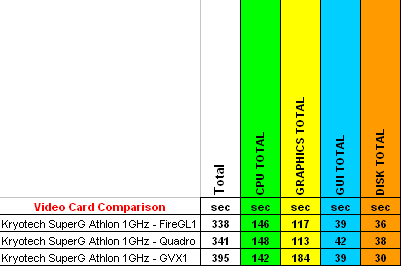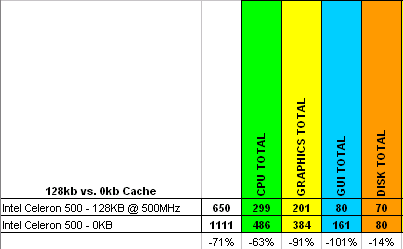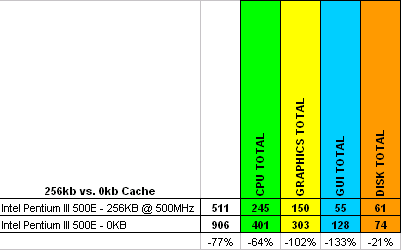Pro/ENGINEER Performance of High End x86 CPUs (Athlon vs P3)
by Anand Shimpi & Dan Kroushl on January 3, 2000 3:38 AM EST- Posted in
- CPUs

For comparison purposes we included two more video cards in our tests, the Diamond FireGL1 and 3DLabs' Oxygen GVX1 which are fairly popular cards in the high end market. The DDR Quadro we used in the tests and the FireGL1 performed quite similarly in the tests, while 3DLabs' GVX1 fell behind in the tests by a considerable degree.
In an effort to answer the question of how much L2 cache is enough, we disabled the L2 cache on both the Celeron and the Pentium III E to see the after effects.

Taking away the Celeron 500's 128KB of full speed on-die L2 cache resulted in a 71% drop in overall performance as is measured by the Total Score of the OCUS benchmark. This is the first very obvious indication that having a high-speed L2 cache makes a very noticeable difference in performance.

Doing the same to the Pentium III E which is outfitted with twice as much full speed on-die L2 cache as the Celeron resulted in a similar drop of 77%. This suggests that the Celeron's 128KB L2 cache may be all that Pro/E needs, at least if your usage patterns can be accurately categorized by the OCUS benchmark. In both cases, the Graphics and GUI tests suffered significantly more than the CPU tests. This leads to the conclusion that the CPU tests must be less sensitive to L2 cache size than the Graphics and GUI tests.










1 Comments
View All Comments
dac7nco - Tuesday, June 28, 2011 - link
My phone is faster than a DEC Alpha; greetings from the future!